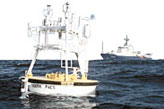Annual Averages of Ocean Reference Stations
Yearly averages of observed meteorogical and surface fluxes show the importance of long term monitoring at select sites in the open ocean. Comparison of model outputs with in situ data shows that observational data is still needed to improve model results.
Data Sources
| Short Name | Source | Reference |
|---|---|---|
| OBS | in situ WHOI-UOP Ocean Reference Station | WHOI |
| ERA | ECMWF ERA-interim | ECMWF |
| NCEP2 | NCEP Climate Forecast System Version 2 (CFSv2) | NCEP |
| MERRA2 | Modern-Era Retrospective analysis for Research and Applications version 2 (MERRA-2) | NASA |
| OAF | Objectively Analyzed Air-sea Fluxes | WHOI |
Meteorogical Data
Meteorological data is presented in tables with the following short names.Meteorological Variable names
| Short Name | Standard or Long Name | Units |
|---|---|---|
| ATMP | air_temperaturedegree_C | degree_C |
| RH | relative_humidity | percent |
| SH | specific_humidity | g/kg |
| SST | sea_water_temperature | degree_C |
| PSAL | sea_water_practical_salinity | 1 |
| WSPDsc | wind_speed (scalar) | meters/second |
| WSPDv | wind_speed (vector) | meters/second |
| WDIR | wind_to_direction | degree |
| SWR | surface_downwelling_shortwave_flux_in_air | W m-2 |
| LWR | surface_downwelling_longwave_flux_in_air | W m-2 |
| RAINtot | thickness_of_rainfall_amount | mm |
| BPR | air_pressure | millibars |
Surface fluxes from ORS sites are calculated with the COARE 3.5 Bulk Flux algorithm (Fairall et al., 1996, 2003, Edson et al., 2012). Data is presented in tables with the following short names.
Flux Variable names
| Short Name | Standard or Long Name | Units |
|---|---|---|
| QB | sensible_heat_flux | W/m2 |
| QH | latent_heat_flux_in_air | W/m2 |
| QN | net_heat_flux | W/m2 |
| Qs | surface_net_downward_shortwave_flux | W/m2 |
| Ql | surface_net_downward_longwave_flux | W/m2 |
| WSSv | magnitude_of_surface_downward_stress (Wind Stress Magnitude vector average) | N/m^2 |
| WSSc | magnitude_of_surface_downward_stress (Wind Stress Magnitude scalar average) | N/m^2 |
| WSSd | Wind Stress Direction | Degrees |
Last updated: October 25, 2016

